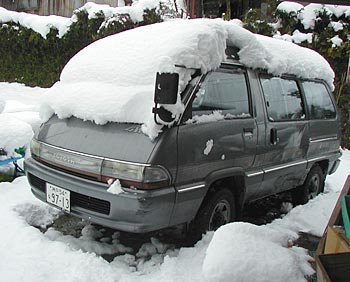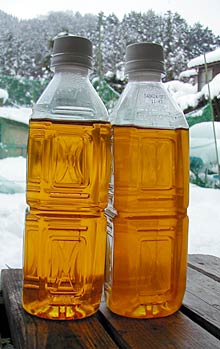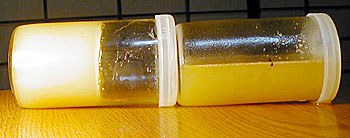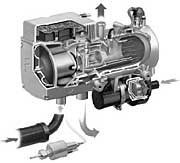
![]()
Search the Journey to Forever website – click HERE
|
Journey to Forever: Make a donation |
En español
Biocombustibles, biodiesel
Navigation
Contact usTo Keith Addison Handmade Projects |
Biodiesel in winter
Some people find their WVO biodiesel starts to gel at around 4-5 deg C (40 deg F). This is because any saturated fats/oils in the WVO will crystallise (solidify) at higher temperatures than unsaturated fats and oils, and separate out, clogging the filter. That includes tallow, lard, palm oil, etc. Make sure you're using winter-grade engine oil. Start with an electrically heated fuel filter, 12V battery or AC mains power, and/or an in-line fuel heater. For details see Fuel heaters, filters. For several years we used Straight Vegetable Oil (SVO) in the summer, and switched to biodiesel in the cold months. Message posted at the start of Japan's worst-ever winter: On Monday (12 December 2005) it snowed, sleeted, gusted and thunderstormed all day and the temperature dropped well below freezing. Since then the days have been sunny but it hasn't stopped getting colder. We filled the tank with ordinary biodiesel, not winterized, with no additives, and it started first time, every time and ran without problems through months of freezing temperatures that often fell to minus 10 or minus 12 deg C (10-14 deg F).

Our Town-Ace after a night of hard snow... but the engine started on pure B100 biodiesel without any problems
The problem
Additives
Winterized biodiesel
Other measures
Heating the fuel
Journey to Forever's solution
The problem
Like petroleum diesel fuel, biodiesel clouds when the weather gets cold, filling with little crystals of wax that can clog the fuel filter. When it gets colder still the biodiesel gels -- it sets solid and won't flow or pour.

Biodiesel made from soy WVO, straight from washing -- we left the bottle on the right outside overnight. The next morning we couldn't find it at first, it was buried in snow. But it just went slightly cloudy. If we'd let it settle for a while first after the wash as we usually do it probably would have stayed clear.
But petroleum diesel fuel, especially winterized or #1 diesel fuel, can take more cold than biodiesel can.
What can you do about it?
Depending on the oils used, biodiesel made from fresh, unused oil has a lower pour-point (or CFPP -- Cold-Filter Plugging Point) than biodiesel made from used cooking oil (UCO, WVO). But, again depending on the oil, WVO biodiesel should be okay to a few degrees below freezing. Ours is fine to about -5 deg C (23 deg F). (We think it helps a lot to process it properly and make high-quality fuel -- see Biodiesel test results.)
Colder than that, the easiest (and least satisfactory) solution is to add winterized petro-diesel to your nice clean biodiesel fuel -- 30% petro-diesel is often used.
Additives
A more satisfactory easy solution is to use a suitable additive -- an antigel or pour-point depressant. There's a range of antigel additives made for use with petroleum diesel, but they don't work very well with biodiesel.
The following additives are specially formulated for use with biodiesel:
http://www.biofuelsystems.com/uk2shop-2.htm
Wintron XC30 -- Biofuel Systems Limited
http://www.powerservice.com/aeba/default.asp?view=app
Arctic Express Biodiesel Antigel -- Power Service Products
http://www.lubrizol.com/BioQualified/additives.asp
Lubrizol BioQualified Cold flow additive for biodiesel (B100)
Paul O'Brien of Biofuel Systems Limited told us this about his company's Wintron XC30: "Wintron XC30 is specifically formulated for biodiesel. It is not EVA-based. EVAs (ethylene vinyl acetate copolymers) are a class of compounds used as pour point depressants for petroleum diesel. I have seen various brands marketed as 'compatible with biodiesel' -- they may be compatible and lower the pour point a little, but they really aren't very good at all... Wintron really does work... There are still some types of biodiesel that can't be winterised, such as tallow biodiesel and palm oil biodiesel due to the fact they are so saturated -- double bonds are needed to modify the viscosity and pour point etc. However, for the great majority of biodiesel fuels, heaters really aren't necessary (other than for extremely cold climates) if Wintron is used."
We tested Wintron X30, and yes, it really does work (see photograph below). Biodieselers in the US tested Arctic Express apparently with good results. We have no independent reports on Lubrizol's product, but Lubrizol is a reputable company and their biodiesel antigel is likely to be effective.
Be aware that these antigel agents contain small amounts of toxic compounds, usually toluene, and must be handled with care.

Two test bottles straight from the freezer at about -10 deg C (14 deg F) -- on the left, no antigel additive, the biodiesel has gelled solid, on the right, 0.5% antigel added (Wintron X30): a bit cloudy but still free-flowing and splashing (and leaking from the lid).
Winterized biodiesel
To make WVO biodiesel for winter, heat the oil first, then cool it to near freezing point; the saturated fats will crystallise out and sink to the bottom. Use the clear oil off the top to make winter biodiesel, keep the stuff at the bottom for summer. But even this "winterized" biodiesel still won't go much below -5 deg C (23 deg F) without gelling.Other measures
If your car won't start in the cold a quick fix is to pour hot tap water over the fuel injectors, the fuel pump and the fuel filter (but keep it away from the alternator). This will usually free up a fuel system clogged by gelled fuel sufficiently to start the engine. Once started, let it idle for at least a few minutes, and when you pull off keep the engine running at low revs until it's well warmed up.
Turning on the glow-plugs two or more times before trying to start the motor can help. Leave the ignition on for a full minute each time, even though the warning light (if there is one) may go out much sooner than that.
Check that all the glow-plugs are working perfectly. They can go wrong and in summer you won't notice it -- in winter you will notice it, but you might think it's a problem with the biodiesel gelling. Maybe not -- have the glow-plugs checked.
Batteries put out less and less power as the temperature drops. The less power it has, the slower it will be able to crank the engine, meaning harder starting, and the sooner it will run out of charge. Careful battery maintenance is especially important in cold weather. Keep the connectors clean, and keep the battery fully charged. And make sure you have a good, strong battery in the first place. If you're facing temperatures lower than about -10 deg C (14 deg F) use a battery charger overnight. Battery blankets are useful and not expensive (about US$30) -- they plug into the AC mains and warm the battery electrically so it can deliver 100% of its power.
Advice from the mailing list discussions: "If you have to jump-start the motor using jump-leads (booster cables) from a car with a good battery, the safe way is to connect the positive terminals first, then connect the negative booster cable to a ground location on the 'good' car, somewhere away from the battery. The last connection should be on the 'dead' vehicle, at a point as far from the battery as you can get."
Check whether your diesel motor has a block heater -- many motors have them as standard. If there is one there should be an electrical plug sticking out of the front of the engine. Plug it into your AC mains overnight or before you want to start the engine. It keeps the engine block warm, as well as the coolant liquid, and also the engine compartment, but not the fuel tank. Block heaters can help a lot. If your motor doesn't have one it might be worth finding out what's involved in getting one installed.
 Tank-type engine heaters connect to a coolant line or heating hose. JC Whitney's "Zerostart" range runs from 750 watts (warms 4-cylinder engines in 2-3 hours) to 2,000-watt heaters for diesels and big V8s, priced from about US$30. "Zerostart" Tank-type Engine Heaters:
Tank-type engine heaters connect to a coolant line or heating hose. JC Whitney's "Zerostart" range runs from 750 watts (warms 4-cylinder engines in 2-3 hours) to 2,000-watt heaters for diesels and big V8s, priced from about US$30. "Zerostart" Tank-type Engine Heaters:
http://www.jcwhitney.com/
Oil pan or sump heaters can warm the engine oil in less than an hour -- the cheapest are the ones that attach to the oil pan magnetically. Flexible dipstick engine oil heaters replace the usual dipstick and will fit curved or straight dipstick holes, for US$20 or less. All these heaters use AC mains power.
An advantage of all types of engine coolant or oil pre-heaters, whether mains- or fuel-powered, is that most diesel pollution comes from starting cold engines -- pre-warmed engines mean much cleaner exhaust emissions and less pollution.Heating the fuel
For heating the fuel in the tank, there are 12V fuel tank heating pads to run off the battery, and AC mains versions to run off house power, both priced at about US$100.
A method that won't overtax the battery is to use the engine coolant to warm the fuel, such as with in-tank/standpipe coolant-operated fuel heaters like the Arctic Fox Hot Fox Fuel Warmer. But what heats the fuel that starts the engine that heats the coolant that heats the fuel? It assumes you're also using a block heater or coolant heater.
Fuel-powered coolant heaters are superior devices -- with superior prices too, but they could be worth it. The main manufacturers are Eberspächer/Espar and Webasto. They might not run on biodiesel, especially if it's cold -- fit a small, separate fuel tank for them filled with petro-diesel. They only use about a cup of fuel an hour and don't take long to do the job. And they warm up the car interior too while they're at it.

Espar's Hydronic 10 Coolant Heater
Espar HYDRONIC coolant heaters
http://www.espar.com/html/products/coolantheaters.html
Eberspächer pre-heaters
http://www.eberspaecher.com/servlet/PB/menu/1003710_l2/index.html
Webasto BlueHeat Coolant Heater
http://www.webastoshowroom.com/blueheat/blueheat_coolantheater.html
One of these, plus a fuel tank heater, either 12V or via the coolant, and an inline fuel heater and/or heated fuel filter should be enough to get you going and keep you going in anything short of extreme cold, independent of mains electricity.
Journey to Forever's solution
Our Toyota TownAce [running on 100% SVO] didn't have any problems until Wednesday night, when the temperature dropped to about -5C, and it was very reluctant to start. It did start in the end though, and took its time warming up.
It has a standard Elsbett single-tank Straight Vegetable Oil system with an electrically heated filter and a coolant heat exchanger, and longer and hotter glowplugs, but no extra heating, and we were still using the standard WVO we've been using since April, not winterised. I'm quite impressed it got this far.
In the temperate countries, this level of pre-heating with an SVO system means trouble-free 100% biodiesel use all year round. More extreme climates will need further measures, see above.
Back to:
Biodiesel and your vehicle
Biofuels
En español -- Biocombustibles, biodiesel
Biofuels Library
Biofuels supplies and suppliers
Biodiesel
Make your own biodiesel
Mike Pelly's recipe
Two-stage biodiesel process
FOOLPROOF biodiesel process
Biodiesel processors
Biodiesel in Hong Kong
Nitrogen Oxide emissions
Glycerine
Biodiesel resources on the Web
Do diesels have a future?
Vegetable oil yields and characteristics
Washing
Biodiesel and your vehicle
Food or fuel?
Straight vegetable oil as diesel fuel
Ethanol
Ethanol resources on the Web
Is ethanol energy-efficient?